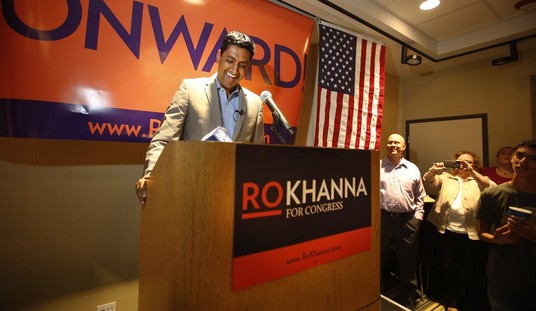“This isn’t about President Trump’s tax returns,” Treasury Secretary Steven Mnuchin told ABC’s George Stephanopoulos, “this is about the American public’s tax returns.” Most of this conversation focused on the former rather than the latter, with Stephanopoulos focusing on the impact of the tax-reform proposal released yesterday afternoon by the White House on the wealthy. Mnuchin insisted that the intent behind this package is to ensure that the middle class gets its taxes cut and the wealthy do not, but continually cited the lack of details in the package prevented firm answers — even to the question of middle-class tax payments.
The point of the proposal is “jobs, jobs, jobs,” Mnuchin repeatedly emphasized, and lifting all the boats by making America more competitive:
ABC Breaking News | Latest News Videos
Treasury Secretary Steve Mnuchin told ABC News today that he couldn’t say how Donald Trump’s sweeping tax overhaul plan would affect the president personally, while also declining to guarantee that middle-class families wouldn’t pay more under the proposal.
“I can’t make any guarantees until this thing is done and it’s on the president’s desk. But I can tell you, that’s our number one objective in this,” Mnuchin said on “Good Morning America.”
The blueprint, which the White House unveiled Wednesday, calls for dramatically cutting federal taxes for businesses and simplifying rules for individuals. The plan would slash corporate taxes to 15 percent for large and small businesses, as well as consolidate categories for individual taxpayers, lowering the top bracket from nearly 40 percent to 35 percent.
But the Trump administration left key questions about the tax plan unanswered, such as how it would affect the middle class and the wealthy.
The problem for Mnuchin is that he’s making this pitch too early in hostile media settings, which this clearly was. The White House proposal turned out to be more like a statement of principles rather than concrete policy, as the Washington Post notes. It ran less than 200 hundred words, and contained few of even the basic details necessary to define its broad outcomes, let alone the specific impacts on various income levels:
On Wednesday, Trump issued a one-page outline for changes to the tax code, pinpointing numerous changes he would make that would affect almost every American.
He wants to replace the seven income tax brackets with three new ones, cut the corporate tax rate by more than 50 percent, abolish the alternative-minimum tax and estate tax, and create new incentives to simplify filing returns.
But the White House stopped short of answering key questions that could decide the plan’s fate. For example, Trump administration officials didn’t address how much the plan would reduce federal revenue or grow the debt. They also didn’t specify what income levels would trigger inclusion in each of the three new tax brackets.
The goal, White House officials said, was to cut taxes so much and so fast that it led to immediate economic growth, creating more jobs and producing trillions of dollars in new revenue and wealth over the next decade.
That may be a goal, but the lack of detail offers little connection between bullet points and outcomes. This kind of press release suffices in campaigns, but is insufficient for governing — and especially for key surrogates who have to go out and sell the proposal. Mnuchin suggests in this interview that the House and Senate will fill in the details, but that leaves a lot of leeway on what has clearly become Donald Trump’s most important legislative priority. It uses the ObamaCare repeal as a launching pad for a massive shift in tax policy that Trump hopes will deliver on his campaign promises to achieve consistent 3%+ economic growth over the next few years — and “jobs, jobs, jobs.”
The problem for the House and Senate, however, will be finding a way to fit this into the reconciliation process. Paul Ryan and Mitch McConnell reserved that path at the beginning of this session of Congress in early January as a means of fitting tax reform through the narrow 52-seat majority in the upper chamber. In order to qualify for reconciliation, however, a bill has to demonstrated a positive impact on the annual deficit. In its present form, even with the ObamaCare repeal eliminating some of the taxes, the Trump tax reform plan will blow a yuuuuuuuge hole in deficit spending, forcing the bill through the 60-vote cloture threshold.
CNN’s Phil Mattingly pointed out the problem this morning:
But the principles laid out Wednesday are A) super aggressive on the cut side and B) skimpy as all get out on the pay-for side. So for example, if you want to lower the corporate rate to 15 percent, from 35 percent, and lower the rate for pass-throughs (think small businesses, owner operated companies and a hell of a lot of other entities like law firms, hedge funds, etc.) to 15 percent, you’re talking about a cost of around $4 trillion. Now, some Republicans are very clear that they’re happy to rely on economic growth to make up as much of that as possible (history shows it’s right to be skeptical of that as a true avenue to pay for cuts.) But therein lie two problems. First, it shuts down the ability to really make broad-based changes to a system everyone thinks is broken. Second — this is as key as it is wonky — Republicans plan to move tax reform through that ever-popular budget process known as “reconciliation.” Positives: Only need Republican votes to get it through. Negatives: It can’t add to the deficit outside of a 10-year window. Now, if I’ve lost you on this, totally understandable, but the short of it is: cuts that steep, particularly without significant revenue raisers, would almost certainly be fatal in trying to do reconciliation …
Just to put a 30,000 foot button on it: House Speaker Paul Ryan and Senate Majority Leader Mitch McConnell have said they want real, permanent, game-changing tax reform. Ryan has put out a plan that is straight-up revenue neutral, comprehensive tax reform. Proposing cuts this steep, and not really giving much indication on how you’d pay for them beyond closing loop holes, cutting deductions and economic growth, makes it far more likely that the White House eventually settles on a “cuts only” strategy, which is the opposite of what top GOP officials want.
In other words, details matter. The massive red ink implied in this proposal might make it a non-starter even within the House Republican caucus. Conservatives just balked at an ObamaCare repeal plan because they didn’t think it went far enough, but they may balk at this one because it goes too far for deficit hawks. If the White House supplied the deductions and closed loopholes they have in mind to demonstrate a ten-year net gain in revenues, then perhaps there might be more enthusiasm for this approach. From the sparse framework provided, however, it looks like the White House might be more interested in having Republicans on Capitol Hill take the political hits for those changes rather than proposing those changes themselves. Rather than take that chance, the GOP might as well stick with the current House tax plan.
Mnuchin has said he’d work with Democrats to get tax reform passed, perhaps a signal to recalcitrant Republicans, but that’s an empty threat. Democrats have gone all in on La Resistance, and they’re not going to suddenly shift gears to give Trump a win on a massive tax cut. Democrats care a lot less about deficit spending, but they do care about appeasing their base, and want to demonize and delegitimize Trump as much as possible. For Democrats, that’s their key to “jobs, jobs, jobs” — for themselves in the 2018 election cycle, they believe.
Paul Ryan called this “a critical step forward” in the tax reform debate, but it might end up being more of a checkbox. Unless the White House starts filling in this framework with some real meat that adds up under reconciliation, the House plan will likely become the core of the tax-reform effort.








Join the conversation as a VIP Member